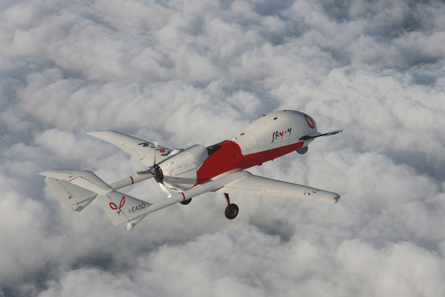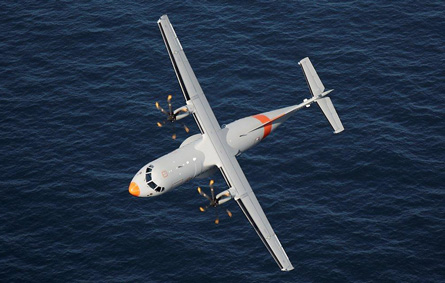Italy's Alenia Aeronautica has set a two-year timeframe to develop and deliver to potential customers a new 1,800kg (3,960lb) maximum take-off weight medium-altitude, long-endurance unmanned air system. This will have a 15h maximum endurance and multi-sensor payload, together with an interoperable tactical control station - all completely developed in Italy using Finmeccanica companies' technology and know-how.
Carlo Logli, Alenia's senior vice-president of special airborne systems, is confident that the company can stick to the challenging schedule it has imposed and offer its new MALE UAS on the international market at a competitive price, free from export restrictions. In the meantime, the Finmeccanica-owned company is actively contributing to the European Neuron unmanned combat air vehicle demonstrator platform, as well as looking to generally expand its co-operation with European companies.
Following the recent completion of Sky-X jet-based technology demonstrator programme - the first UAS with an MTOW over 1,000kg to fly in Europe - Alenia has focused its activities in the conventional unmanned platform sector on the Sky-Y platform, with the aim of supporting the development of a surveillance UAS with dual-use capabilities for military and civil applications and operational scenarios.
 |
|---|
© Alenia Aeronautica |
The 1,200kg-MTOW Sky-Y, along with its sensors package and interoperable tactical control station, is in the final stage of its fourth flying campaign, operating from the Italian air force's Decimomannu base in Sardinia. Conceived to be completely developed and equipped in Italy, it includes an automotive-derived heavy-fuel diesel engine with a dual full-authority digital engine control system.
The fourth flying campaign was primarily intended to test and evaluate a flight-control system developed in collaboration with Alenia Aeronautica subsidiary Alenia SIA, which already supplies other flight control systems such as that equipping Aermacchi's M-346 Master advanced jet trainer. Additionally, Selex Communications' new line-of-sight wideband datalink was tested for the first time, as were upgrades to Selex Galileo's EOST-45 electro-optical/infrared (EO/IR) package.
The new 1,800kg maximum takeoff weight Sky-Y-configured MALE UAS is characterised by a new airframe with a 16.7m (55ft) wingspan and 195hp (145kW) diesel engine, capable of a maximum endurance of 15h with a 250kg multi-sensor payload, including Selex Galileo's EOST-45/46 EO/IR system and PicoSAR active electronically scanned array (AESA) high-resolution radar and Selex Communications' satellite wideband datalink, controlled by the already developed interoperable tactical control station.
The new product will not fall within the scope of the USA's International Traffic in Arms Regulations (ITAR). Alenia says it is in discussion with a potential international customer to jointly develop the new UAS, with either an agreement or a decision to go alone due by the end of 2010.
Alenia's participation in the Neuron programme - together with Selex Galileo and other Italian companies - is considered by Logli "fundamental to validate technologies to be applied to future unmanned and eventually manned ISR [intelligence, surveillance and reconnaissance] or combat platforms to be developed by European nations as a successor to Eurofighter Typhoon, maintaining a know-how which otherwise would disappear".
Additionally, Alenia is working with UK-based BAE Systems group on a pre-feasibility study for a potential jointly developed MALE under the aegis of a bilateral agreement between the UK and Italian ministries of defence.
ALL AT SEA: THE NEW FRONTIER
In an era of swingeing budget cuts, world air forces and navies are looking for affordable maritime patrol platforms that can accomplish a wide range of missions, from homeland or constabulary duties to maritime surveillance and anti-surface (ASuW) or anti-submarine (ASW) warfare.
Alenia is marketing its ATR 42MP Surveyor on its low operating and acquisition costs. Nine aircraft have already delivered, to the Italian coastguard (three), the Italian customs service (four) and Nigeria (two), in a customised configurations. The mission suite can include the latest version of Selex Galileo's ATOS (airborne tactical observation and surveillance) mission management system, Elettronica's electronic surveillance measure, Selex Communications radios and datalink and Selex Galileo's AESA surveillance radar and high-resolution EO/IR product, says Logli. "We expect to deliver a single ATR 42MP to the Libyan government after the summer, while more orders could come from contract options", he adds.
 |
|---|
© Alenia AeronauticaAlenia is marketing its ATR's 42MP Surveyor |
As part of a strategy to enlarge its products portfolio, Alenia developed and is marketing a dedicated version of ATR 72 platform, which in addition to maritime surveillance, search and rescue, and homeland security duties can perform overland ISR (intelligence, surveillance and reconnaissance) and ASW/ASuW missions with torpedoes and anti-ship missiles.
The first contract for this version was signed by Turkey's defence procurement authority SSM in July 2005. It covered the procurement of 10 ATR 72s and their modification and equipping with ASuW and ASW mission systems for the Turkish navy's Meltem III programme.
The second contract was awarded in December 2008, when Italian ministry agreed to take four ATR 72MPs equipped with maritime surveillance mission suites, with the option of upgrading to a full ASW/ASuW configuration, including external modifications. Alenia hopes the customer will commit to these enhancements by year end.
The first ATR 72-500 platform arrived in Turkey on February 2008 and is being worked on by Turkish Aerospace Industries, which as main subcontractor to Alenia is carrying out modifications at its facilities, in addition to mission systems integration design and installation, ground flight support, equipment procurement and integrated logistics support, together with other Turkish companies.
Both of Alenia's ATR 72 maritime patrol aircraft customers are to received ATR's new 72-600 platform, which is undergoing testing. The 72-600 is characterised by a Thales Avionics glass cockpit and uprated Pratt & Whitney PW127M engines.
With Turkey's Meltem III programme, the mission suite is provided by Thales Airborne Systems and includes an AMASCOS (airborne maritime situation and control system) 300 mission management system with four operator consoles, an Ocean Master 400 surface surveillance radar, an electronic support measures suite and an acoustic processor unit, in addition to a sonobuoys launcher and magnetic anomaly detector, a communications suite with Link 11/16 tactical datalinks and a self-protection suite. The Turkish partners are Aselsan, Havelsan and Milsoft.
The ATR-72-600 for the Turkish navy features four external hard points for light torpedoes and depth charge, but has also been designed to carry anti-ship missiles such as an MBDA Marte family model. According to SSM, mission systems suite integration delays require a programme schedule realignment and configuration changes, which it expects to agree later this year. Logli says ATR will provide the first Italian ATR 72-600 to Alenia laster this year for modification, equipage and flight testing, with certification and delivery to the customer following in the second half of 2012 and, subsequently, handovers taking place at two-months intervals.
The Italian ATR-72MP features a maritime long-range surveillance version of Selex Galileo's ATOS mission suite, managing a variety of sensors, communications, electronic support measures, and self-defence systems. The package includes Selex Galileo's Sea Spray 7300E AESA radar and EOST-23 electro-optical turret, Elettronica's electronic support measures and electronic intelligence suite with a C27J-based self-protection subsystem, including the option to add Elettronica ELT-572 DIRCM (directional infrared counter measures) and a Selex Communications' package including satcom-capable radio and Link 11/16 tactical datalinks.
With a maximum take-off weight of 22.8t, the ATR 72MP can operate for more than 6.5h up to 200nm (370km) from its base, with a crew of two pilots and four operators or observers. Alenia claims the ATR 72MP ASW version is receiving strong interest from the market worldwide and is being proposed to Oman, Malaysia and India, among others.
- All the latest news, video and images from the 2010 Farnborough air show - New this year, live streaming video of each day's flying display
Source: Flight Daily News























